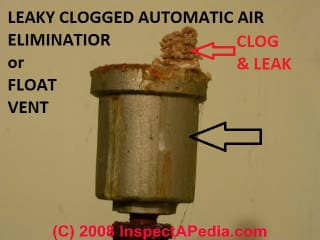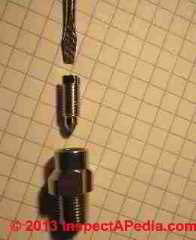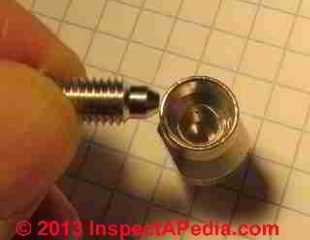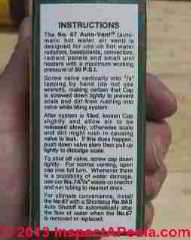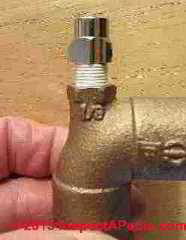
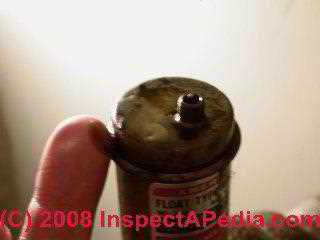
Heating Boiler Air Eliminator or
Baseboard / Radiator Air Vent Leak Repair
How to unclog or replace screw-type manual air bleeders & automatic air vents
- POST a QUESTION or COMMENT about troubleshooting problems bleeding the air out of hot water heating system radiators, baseboards, convectors etc.
Leaky hot water heating system vent repairs: how to repair a leaky hot water air vent or bleeder valve. Herre we explain how to repair or replace both manual heating system air bleed valves and automatic float type air vents that are leaky.
Float type automatic vents on hot water heating systems are normally left "open" to automatically purge air from the system.
But a float vent that leaks water will stop working, may leak onto and damage equipment, and is often left "closed" or shut off as a temporary measure. And a manual air vent that is leaky or that no longer vents due to corrosion and clogging is not going to do the job when your heating system is airbound and radiators or baseboards are cold.
Page top photos: at left, a manually operated air bleeder usually found at one end of hot water heating baseboard runs and at right, an automatic float type air bleeder valve.
InspectAPedia tolerates no conflicts of interest. We have no relationship with advertisers, products, or services discussed at this website.
- Daniel Friedman, Publisher/Editor/Author - See WHO ARE WE?
Air Bleed / Air Vent Valve Leak Repair: How to Inspect and fix or replace manual air bleeder valves (air vents)
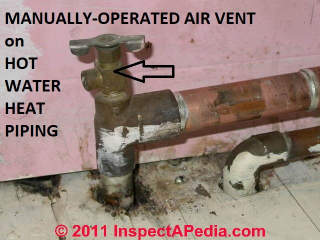 First, what kind of air purging or air bleeding device are we diagnosing, fixing, or replacing?
First, what kind of air purging or air bleeding device are we diagnosing, fixing, or replacing?
There are two basic air vent types used on hot water heating systems:
- Manual air bleeders (shown just above)
that are opened by a small screw or handle, located at one end of heating baseboards - Automatic float-type air eliminators (below on this page)
that may be found at the heating boiler, at heating zone piping near the boiler or elsewhere on the heating system
If your air vent looks like the little device shown just above or like the device shown on a hot water baseboard piping elbow at the top of this page the it's a manually-operated air vent - and this page will tell you what you need to know.
If your air vent looks something like the device shown just below, that's an automatic air eliminator or "float vent" that we discuss in more detail
in more detail at AIR ELIMINATOR / FLOAT VENT REPLACEMENT. A leaky automatic air vent should be replaced by removing the old and screwing-in the new vent device.
Watch out: don't try the repairs described in this article series if you are not familiar with basic plumbing repair procedures and don't try this repair without cooling down the boiler to avoid scalding burns. Call your plumber or heating service technician instead.
Additional automatic air bleeder valves may be installed at other points on the hot water piping, usually at a higher spot near the boiler and sometimes on upper floors in the building.
Look for and check the operation of these air bleeder valves too.
Really? On occasion a heating system may be air-bound, causing some or all of its heating devices to remain cool or cold, but the air is in a place where the existing air vents won't get rid of it.
Steps to force air out of an airbound heating system when the automatic or manual air purgers aren't doing the job are
at AIRBOUND HEAT SYSTEM REPAIR by WATER FEED VALVE.
How to Protect the Building from Water Damage from a Leaky Air Purge Vent
If water starts to leak out of the air bleeder valve continuously (photo at left) (it's ok for a drop or so to be expelled if the leak stops quickly) then screw the cap down tight again and ask your heating service technician to replace the valve.
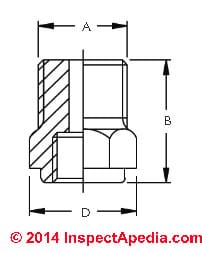 Taco® provides a neat little attachment, the Taco Hy-Vent waste connector (sketch at left, adapted from Taco's product literature), that connects to the company's Hy-Vent air purger. The Hy-Vent waste connector allows the Taco Hy-Vent's outlet to be connected to a suitable drain location so that should the valve begin to leak through its vent opening water will be directed to a drain without damaging the building.
Taco® provides a neat little attachment, the Taco Hy-Vent waste connector (sketch at left, adapted from Taco's product literature), that connects to the company's Hy-Vent air purger. The Hy-Vent waste connector allows the Taco Hy-Vent's outlet to be connected to a suitable drain location so that should the valve begin to leak through its vent opening water will be directed to a drain without damaging the building.
Watch out: Taco warns that while connecting a 3/4" flexible hose to the air vent outlet can suit to protect building areas from water damage, do not solder a connection to the air vent valve. Soldering the air vent outlet will cause it to fail to operate properly.
[Click to enlarge any image]
In our OPINION it would be smart to also inspect for leaks at any and all piping connections, including the threaded air vent mounts, and it would be smart to direct a waste connector vent drain to a location where somebody will notice that the vent is leaking so that proper repairs can be made.
Watch out: reading the installation literature from a variety of air eliminator and air vent manufacturers we observe that instructions about how to leave the air vent valve cap vary. Generally the cap is left loose to permit automatic air purging from float type air vents and partly loose to permit automatic air venting from some models of coin vents. But some instructions such as for the Honeywell EA79 Air Vent want you to leave the vent cap shut, stating
Make sure that the red vent cap is securely tight, and that the valve is in the closed position by turning the vent body clockwise.
Use hands only [to tighten the valve] to avoid damaging the vent.
Operate the EA79 by turning the vent body counterclockwise to the open position. Make sure the red vent cap is tightened all the way to the stop position for proper leakage guard operation. - Honeywell Braukmann EA79 Industrial Air Vent installation instructions.
How to Fix or Replace Corroded or Leaky Manual Air Bleeder Valves
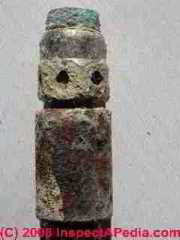
Is the air bleeder valve corroded? If the air bleeder is thick with corrosion or mineral deposits (photo at left) it has probably been leaking water when it should not, and it probably needs replacement.
If the air bleeder valve is badly corroded or coated with mineral deposits it's safer to leave the valve alone. Picking at a corroded plumbing or heating component of any sort risks starting a leak that you cannot stop without having to shut the entire system down. Call your heating service technician to have the valve replaced.
Inspect and use or replace manual air bleeder valves on the heat distribution piping:
Problem spot manual air bleed valves:
If a building heating system has experienced previous problems with air blockage in the heating system a technician may have installed a manual bleed valve at a strategic location to get air out of a problem section of piping. Look for valves that resemble the one shown in our photo.
Problem finding all of the air bleeder valves:
air bleed or air purge valves on hot water heating piping or baseboards can be hard to find. Usually, in addition to one or more automatic air purge valves found at or close to the heating boiler itself, you will find an automatic or manual air purger at the higher end of a section of heating baseboard that has become air-bound in the past.
Leaky air bleeder valves:
I find leaky air bleeder manual air bleed valves as well as automatic or float type air vent valves on heating systems.
Sometimes the manual air vent is leaking just because the manual air bleed valve was left open
or was abused by a heavy-handed operator who over-torqued its fittings and damaged screw threads or a seating gasket
Tips for Step by Step Replacement of a Damaged or Leaky Manually-operated Air Bleeder or Vent are
at AIR BLEED VALVE INSTALLATION
Tips for step by step diagnosis and replacement of a clogged or leaky automatic air bleeder or air eliminator valve
are at AIR ELIMINATOR / FLOAT VENT REPLACEMENT
Problem getting the old corroded air bleeder valve out? Or trouble removing a cast iron or steel plug on a radiator where you want to install an air bleeder valve?
See RADIATOR PLUG REMOVAL for a suggested procedure as well as for steps to recover your radiator if the vent mounting hole threads are badly corroded or stripped.
Manual Air Bleed Valve Cleaning & Parts
Above you can see a disassembled manual air bleed valve. The smaller threaded stopper component screws into the center of the air bleeder body until its tapered tip is snug against the valve seat. And below in our close up photo you can see the tapered air bleed valve seat against which the rotating stopper meets.
Below you can see the vent opening in the side of this air bleed valve. When we unscrew the center stopper in this valve (turning the screw counter-clockwise or from right to left), we open the valve just enough that air can pass through the bleed valve body and out at this vent opening.
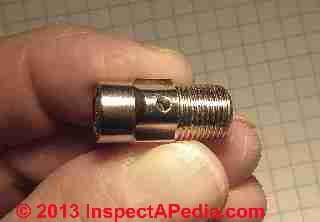 Watch out: You do not normally need to fully remove the bleed screw, and you shouldn't. If you remove the inner screw completely you'll have a hell of a time fumbling it back in place when hot water comes squirting in your face. Don't do it.
Watch out: You do not normally need to fully remove the bleed screw, and you shouldn't. If you remove the inner screw completely you'll have a hell of a time fumbling it back in place when hot water comes squirting in your face. Don't do it.
Just one full turn should be enough to permit air (if present) and ultimately hot water from the heating piping system (when there is no air present) to squirt out of the vent.
(On the air bleed valve shown here, about six full turns of its center screw will completely remove that component from the valve body.)
As soon as water begins to exit the vent body you should close the screw by turning it clockwise to a firm, closed position. Wipe off the vent body and check that it is not leaking.
The vent shown and most of its sisters are made of stainless steel, are corrosion resistant (not corrosion proof), and should not easily clog with debris.
How to Clean Debris from a Clogged Air Bleeder Valve
If on turning the air bleed vent screw one full turn no air and no water vent out of the bleeder, either the baseboard, pipe, radiator, or convector being bled is completely empty of water and is under no pressure whatsoever (abnormal conditions) or the valve opening or its vent exit opening may be blocked with debris.
Small bits of debris will normally vent successfully through the vent opening shown above when the valve is opened.
For an air bleeder that is covered with mineral deposits or lime from prior leaks, you could remove the valve, disassemble its parts, soak them in vinegar over night to loosen the lime, but frankly that's a risky approach. Given the trouble and disruption of removing an air bleed valve in the first place, and the risk that it will still leak on re-installation, just replace it instead.
Watch out: do not try to clean an air bleeder valve seat using abrasives.
For successful closure, the air bleeder valve shown depends on a good fit between the tapered screw tip and the tapered valve seat in the valve body.If you scratch or scrape the valve seat or the mating face of the valve screw the valve may fail to seal completely. The air bleeder does not contain any plastic or rubber seals.
Reader Question: how do I solve problems with leaks at an air bleed valve and air remaining in the heating system?
I recently installed a new hot water furnace in my house. I did the job myself and everything is working ok except that the automatic vent valve constantly needs to be opened to let out air.
I left the cap loose so that it could vent automatically but then it leaked. Do you think that the valve is bad or is not placed in the proper location ? Any help would be appreciated. - E.M. 12/27/12
Reply:
E.M. A competent onsite inspection by an expert usually finds additional clues that help accurately diagnose a problem with air bleeding or air leaks into hot water heating systems. (Incidentally, for clarity we call hot water heating systems heating boilers or hydronic boilers - furnaces are generally warm air heating systems).
That said, if you are continually seeing air bleeding out of your air bleed valve then I suspect that either you have not fully bled all air out of the system or there is a leak somewhere that is both letting water out and air in to the heating boiler or its piping and radiators / baseboards. I suggest checking all of the heat piping, baseboards, radiators &c. to see if everything is getting hot.
if your system is successfully circulating hot water through all of the piping and heating devices but there is still air in the system (and if there are no leaks) then it should be pretty easy for the automatic air bleeders (properly located at high points on the boiler and on the heat distribution piping) to purge the remaining air.
Air Coming out of the Bleeder is OK, Water Coming out of an Automatic Air Vent Means Valve Replacement is Needed
 Observing air coming out of an air bleeder is not an indication of a faulty air bleed valve.
And if you are indeed seeing air venting out of the valve its location is a functional one. However that does not mean that it's the only air bleed valve needed.
Observing air coming out of an air bleeder is not an indication of a faulty air bleed valve.
And if you are indeed seeing air venting out of the valve its location is a functional one. However that does not mean that it's the only air bleed valve needed.
What would be a fault would be water coming out of the air bleeder valve, such as I demonstrate in my photo at left.
[Click to enlarge any image]
Float type air bleed valves are supposed to stop venting once water enters the valve body.
I agree that if water is leaking out of the air bleed valve that's not an acceptable condition - the valve needs to be cleaned (try purging a little water through the valve to flush the valve seat) or replaced.
In an emergency I too would leave the air bleed valve cap shut tight to stop a leak but I wouldn't leave that as a long term solution, as leaving the cap tight also prevents the valve from bleeding excess air from the system. If you can't get the valve to stop leaking, try replacing the valve core stem or replace the entire valve.
Typically we see an air bleeder located close to (above) the boiler itself and one or more located at high points in the heat distribution piping.
If you are having trouble bleeding air out of your system you might need to add another air bleeder at the high end of a heating distribution loop, or you might need to follow our suggestions for manually forcing excess air out of a system.
See AIRBOUND HEAT SYSTEM REPAIRS
Reader Question: Leaky air bleeder on a Slant-Fin "radiator"
We live in a 45-year old house with baseboard Slant-Fin radiators. One of the air bleeder valves has started to leak, It's a slow leak. but enough to do some real damage if we don't fix it. Upon inspection, we found that all the bleeder valves in the house are horribly corroded and would like to have them replaced
I don't want to attempt this myself (I'm somewhat handy, but the thought of screwing up and losing our heat in the middle of the winter is horrifying) So what kind of specialist should I call? - Dave Selander 3/4/12
Reply:
A heating service technician or a plumber experienced with hot water heating piping can do the job you describe. It's least disruptive to schedule the repairs for out of the heating season.
When Should a Heating System Air Vent Valve Cap Be Left Open or "Loose"
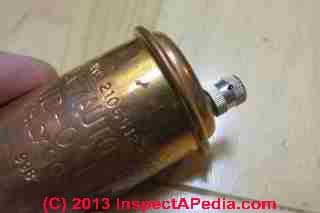 Opening up a an automatic air purge valve whose cap was closed
Opening up a an automatic air purge valve whose cap was closed
If loosening the valve cap does not make water leak out, leave the cap loose.
This permits float type air purge vents and some other automatic air vents to do their work. If the valve is leaking you will need to leave the cap closed tightly to avoid water leaks and damage, but you should then replace that float vent or auto-vent at next system service.
Shown at left, the air vent cap on a Maid-O-Mist No. 67 auto vent, automatic air eliminator. Notice the vent hole in the device cap? When this valve cap is left loose air can vent out of this opening.
[Click to enlarge any image]
Watch out: make a list of the locations of all of the air vents on your heating system and post it near the heating boiler. An occasional inspection of each vent for signs of leakage can stop trouble before it results in loss of heat or water damage to the building interior.
Watch out: for automatic and some manual air vents the operating water pressure in the heating (or cooling water) system must be higher than atmospheric pressure. Otherwise when the vent or valve is opened air may enter the piping system rather than being purged from it.
We describe this problem at AIR BLEED VALVE INSTALLATION.
Also see AIR BLEEDER VALVE FUNCTIONS
Watch out: some air bleeder vents come with instructions indicating that the vent cap is to be left shut, not open. Be sure to read the specifications and instructions for your air bleeder vent before making a change in the tightness of the vent cap.
Reader Question: Installing hot water heating piping air bleeder valves: leave the bleeder cap loose?
There is a lot of great information here. Definitely helpful for some things and the images are also a plus.
I have one 8' stretch of baseboard pipe that isn't heating up. It's the middle room (my 1 y/o sleeps there) of 3 bedrooms. Both other bedrooms are fine.
There are 2 new automatic bleeder valves on each end of the baseboard. I've tried slightly opening the screw valve with no luck. There is a supply and return on this stretch of baseboard (mono flow system?).
The lower pipes get hot but it's not making it past the valves to the coils.
I am lead to believe this is the highest point in the house. I've tried turning the system on and than bleeding and still unsuccessful. As mentioned, both bleeder valves are fairly new with no corrosion or water leaks. What else can I do? Dad needs his sleep as his little one keeps waking him up so help is abundantly appreciated. - LB
I have cracked one of the valves and an ever so slight amount of air comes out but not enough to get the water flowing. I'm guessing I may need to bleed all the water from the system and start from scratch. I'm just glad that it appears to be an air blockage and not something more serious.
Just for reference, I should keep the caps slightly open to allow air to dispel when necessary or should I keep them tight and manually crack them from time to time? - LB [continued]
Reply: it depends on the air bleeder valve type
LB:
If a section of baseboard is cold but pipes leading to it are hot quite possibly it is airbound as you suspect. Possibly the air bleeders are defective; with the system at full operating pressure and temperature, careful (avoid burns, spills) manual bleeding might dump enough air to get things going, else you may need to try replacing one or both valves.
Or use the alternative air purge methods
at AIRBOUND HEAT SYSTEM REPAIR by WATER FEED VALVE
LB:
If you're not getting the air out at a bleeder and you're sure the bleeder is not clogged, be sure that the heating system is up to operating pressure and temperature. If still you can't get the air out, you'll need to force water through the piping at higher pressure.
Finally, we can categorize air bleed valves on hot water heating systems into roughly two groups:
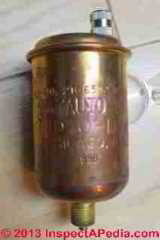
Automatic air bleeders, often including a float valve that drops to open the bleed valve to purge air when air accumulates in the float body - on these valves the manufacturer instructs to leave the valve cap loose so that the valve can vent automatically.
An automatic air bleeder at the boiler or in a utility area should pretty much always have its cap left loose so that it can do its job.
At above left is an automatic air vent, the Maid O Mist No. 67 auto-vent. Instructions for this air vent are shown in the second photo (above-right) For a Maid O Mist No 67 auto vent, normally the vent cap should be left open one full turn from its closed position.
If the valve is leaking water at that location you can close the cap to stop the leak (and prevent air venting) temporarily until you replace the leaky valve - a step that should be done promptly to minimize the risk of lost heat due to an airbound heating system.
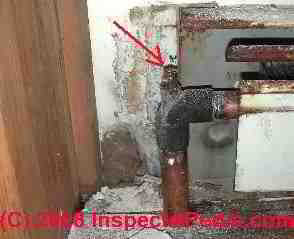 [Click to enlarge any image or photo at InspectApedia]
[Click to enlarge any image or photo at InspectApedia]
Watch out: an automatic air bleed valve with a loose cap, installed on a heating baseboard in the living area, can present a risk of water leaks into the building floor (or ceilings below), if it's not inspected and if necessary cleaned or replaced.
In this location some heating techs and plumbers avoid the leak risk by just keeping the cap tight on the valve.
The valve won't automatically purge air (you are relying on other air purgers elsewhere in the system for automatic air purging), but it can still be opened and activated if necessary to purge air from the particular high hot water piping loop that it serves.
Manual air bleeders (photo at above-left), usually don't even have a cap, but might. These are kept closed except when in use.
Leaving the Manual Air Bleed Valve Shut: a tricky way to "shut off" radiators in older homes by not bleeding air out of the radiator
Sometimes in older homes the heating radiator control valves are stuck and cannot be operated. Usually the radiator valve will be stuck in the "open" position because no one wants to live with no heat in cold weather.
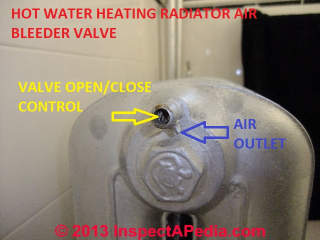 When we lived in a 100 year old home in Poughkeepsie, New York, ever fall we found that some radiators had become full of air over the summer when the heating system was off.
When we lived in a 100 year old home in Poughkeepsie, New York, ever fall we found that some radiators had become full of air over the summer when the heating system was off.
For a few rooms where we didn't want heat, and where the radiator control valve was "stuck" in the "open" position, we found that if we simply neglected to bleed air from that radiator it wouldn't heat up when the rest of the heating system was operating.
Over at RADIATOR VALVES & HEAT CONTROLS you'll see more photos of radiator control valves.
On all hot water radiators the heating control valve that turns the radiator on or off will be at the hot water inlet pipe to the radiator and may be located near the radiator top or bottom.
There are a few air bleeder valves that have a tiny round handle, maybe 1" in diameter, but they will be mounted right onto the radiator body itself, not on the piping.
This article series provides a detailed guide to using air bleed valves to get rid of unwanted air in hot water heating systems: fix cold or noisy hot water heating radiators or baseboards.
How to Remove & Replace a Painted-in Rusted-in Pipe Plug or Air Bleeder From a Radiator
This topic has moved to RADIATOR PLUG REMOVAL
Details of How to Remove & Replace a Leaky or Defective Float Vent or Bleeder Valve
If you need to diagnose a cold radiator or convector unit or baseboard that may be air bound OR if you need to replace an existing automatic air vent or float vent or automatic air bleeder,
see AIR ELIMINATOR / FLOAT VENT REPLACEMENT
If you have already removed an old pipe plug or air bleeder vent from your radiator or if you don't anticipate any trouble getting the old one out, the procedure
at AIR BLEED VALVE INSTALLATION will suffice.
...
Continue reading at AIR ELIMINATOR / FLOAT VENT REPLACEMENT or select a topic from the closely-related articles below, or see the complete ARTICLE INDEX.
Or see AIR BLEED VALVE LEAK REPAIR FAQs - questions and answers posted originally on this page. There we include additional examples of other types of air bleeder vents or air eliminators and give a bit of air eliminator history and patents.
Or see these
Related Articles
- AIR BLEEDER VALVES - home
- AIR BLEEDER VALVE FUNCTIONS
- AIR BLEED VALVE INSTALLATION
- AIR ELIMINATOR / FLOAT VENT REPLACEMENT
- AIR BLEED VALVE LEAK REPAIR
- AIR BLEED VALVE SOURCES
- AIR-BOUND HEATING SYSTEMS - home
- AIR ELIMINATORS for POTABLE WATER SUPPLIES to remove air from water supply systems, piping, fixtures.
- AIR SCOOPS PURGERS SEPARATORS
- EXPANSION TANK AIR VALVE LEAKS for leaks at the air adjustment valve on a boler expansion/compression tank
- RADIATOR PLUG REMOVAL
- RADIATOR VALVES & HEAT CONTROLS
Suggested citation for this web page
AIR BLEED VALVE LEAK REPAIR at InspectApedia.com - online encyclopedia of building & environmental inspection, testing, diagnosis, repair, & problem prevention advice.
Or see this
INDEX to RELATED ARTICLES: ARTICLE INDEX to HEATING RADIATORS
Or use the SEARCH BOX found below to Ask a Question or Search InspectApedia
Or see
INDEX to RELATED ARTICLES: ARTICLE INDEX to HEATING BOILERS
Or use the SEARCH BOX found below to Ask a Question or Search InspectApedia
Ask a Question or Search InspectApedia
Try the search box just below, or if you prefer, post a question or comment in the Comments box below and we will respond promptly.
Search the InspectApedia website
Note: appearance of your Comment below may be delayed: if your comment contains an image, photograph, web link, or text that looks to the software as if it might be a web link, your posting will appear after it has been approved by a moderator. Apologies for the delay.
Only one image can be added per comment but you can post as many comments, and therefore images, as you like.
You will not receive a notification when a response to your question has been posted.
Please bookmark this page to make it easy for you to check back for our response.
IF above you see "Comment Form is loading comments..." then COMMENT BOX - countable.ca / bawkbox.com IS NOT WORKING.
In any case you are welcome to send an email directly to us at InspectApedia.com at editor@inspectApedia.com
We'll reply to you directly. Please help us help you by noting, in your email, the URL of the InspectApedia page where you wanted to comment.
Citations & References
In addition to any citations in the article above, a full list is available on request.
- "Residential Hydronic (circulating hot water) Heating Systems", Instructional Technologies Institute, Inc., 145 "D" Grassy Plain St., Bethel, CT 06801 800/227-1663 [home inspection training material] 1987
- Boilers, Boiler Conversions, James E. Brumbaugh, ISBN 0-672-23389-4 (v. 1) Volume II, Oil, Gas, and Coal Burners, Controls, Ducts, Piping, Valves, James E. Brumbaugh, ISBN 0-672-23390-7 (v. 2) Volume III, Radiant Heating, Water Heaters, Ventilation, Air Conditioning, Heat Pumps, Air Cleaners, James E. Brumbaugh, ISBN 0-672-23383-5 (v. 3) or ISBN 0-672-23380-0 (set) Special Sales Director, Macmillan Publishing Co., 866 Third Ave., New York, NY 10022. Macmillan Publishing Co., NY
- Installation Guide for Residential Hydronic Heating Systems
- Installation Guide #200, The Hydronics Institute, 35 Russo Place, Berkeley Heights, NJ 07922
- "Residential Hydronic (circulating hot water) Heating Systems", Instructional Technologies Institute, Inc., 145 "D" Grassy Plain St., Bethel, CT 06801 800/227-1663 [home inspection training material] 1987
- Installation Guide for Residential Hydronic Heating Systems
- Installation Guide #200, The Hydronics Institute, 35 Russo Place, Berkeley Heights, NJ 07922
- In addition to citations & references found in this article, see the research citations given at the end of the related articles found at our suggested
CONTINUE READING or RECOMMENDED ARTICLES.
- Carson, Dunlop & Associates Ltd., 120 Carlton Street Suite 407, Toronto ON M5A 4K2. Tel: (416) 964-9415 1-800-268-7070 Email: info@carsondunlop.com. Alan Carson is a past president of ASHI, the American Society of Home Inspectors.
Thanks to Alan Carson and Bob Dunlop, for permission for InspectAPedia to use text excerpts from The HOME REFERENCE BOOK - the Encyclopedia of Homes and to use illustrations from The ILLUSTRATED HOME .
Carson Dunlop Associates provides extensive home inspection education and report writing material. In gratitude we provide links to tsome Carson Dunlop Associates products and services.


